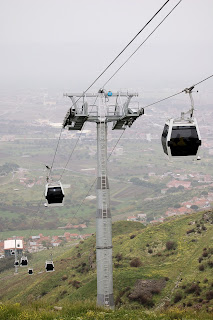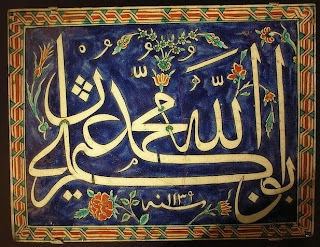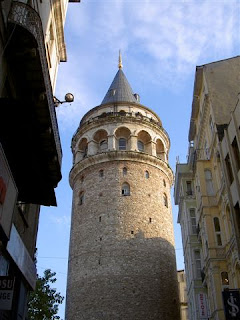Posts
Showing posts with the label Ancient World
Bergama (Pergamon)
- Get link
- X
- Other Apps

The modern town of Bergama is not particularly picturesque town and I certainly wouldn't recommend it as a destination from which too base your holiday, however it has a fascinating history making it perfect for a day trip. The older part of the town has some old style town houses and its not overly touristy so can be a nice place to observe the Turks going around their day to day business. Attractions at Bergama include two large archaeological sites, a museum of archaeology and a gargantuan brick temple earmarked as the throne of the devil in the coming Armageddon. Museum of Archaeology in Bergama The museum at Bergama is well established having been built on the orders of Fevzi Çakmak in 1932. Recently it has been refurbished to a high standard. The exhibits are mostly from nearby Hellenistic, Roman, Byzantine and Ottoman remains. Outside the front of the museum there is a collection of sculptures and decoratively carved Islamic tombs and grave markers. Inside there are m...
Gemiler Island (St. Nicholas Island)
- Get link
- X
- Other Apps

Gemiler Island also known as the Island of St Nicholas is located on the Mediterranean coast of Turkey between Olu Deniz and Fethiye. The Island is only small approximately 1000m long by 400m wide but that small area is littered with the remains of an historic monastic retreat containing among other things the original resting place of St Nicholas. The Island offers the perfect opportunity to take a break from sunbathing and spend an hour exploring the medieval remains, that for centuries attracted pilgrims from all over Christendom. On the island are the remains of four churches, related religious buildings, Byzantine dwellings, harbour, cistern, stone tombs, graveyard and ceremonial passageway. The views from the top of the Island across the Mediterranean and back inland are also quite stunning and well worth the walk. The Tomb of St Nicholas St Nicholas better known now days as Father Christmas or Santa Claus was the Bishop of Myra, which is just a few miles from from Gemiler Isl...
Ottoman Calligraphy
- Get link
- X
- Other Apps

This is a sponsored post in courtesy of The Pen Company Ottoman calligraphy began its life when the Turks migrated from Central Asia towards Asia Minor coming into contact with Islam along the way, they abandoned the traditional Uyghur text and adopted a hybrid written language based on Persian and Arabic tradition. In Islamic theology the text of the Qur'an is considered sacred as it is the word of Allah himself as revealed to the prophet Muhammed. This combined with the fact that artworks picturing human and animal forms are prohibited, meant that calligraphy as an art form flourished in the Ottoman empire with the most impressive works being undertaken in Istanbul. Istanbul became the capital of the Ottoman state in 1453 after Fatih Mehmet took the city effectively ending the Byzantium empire. Within Istanbul there are many fine examples of Turkish calligraphy one of the most famous being engraved in 1478 over the imperial gate at Topkapi palace by Ali Sofi a calligrapher in t...
KayaKoy, A Greek ghost town in Turkey
- Get link
- X
- Other Apps

Kayaköy (stone village) A fascinating and eerie ghost town lies in the hills between Olu Deniz and Fethiye hastily abandoned when its Greek population was repatriated in 1923 after the Greco-Turkish war. Since then the town has been left bare to the elements and hundreds of intact but roofless houses sit empty staring across the valley. For 8YTL you can wander the houses, shops, schools, windmills, tavernas and churches of this beautiful and serene place. Entering the houses is weird as you get a feeling of being somewhere you shouldn't be, as if someone had left their front door open and you took it upon yourself to nose around. Even the goats that wander the village chewing on weeds have a tendency to look at you like an unwelcome interloper. The absence of sound is striking and even though we were virtually the only visitors we still spoke in hushed tones. Its like a community in stasis except without the people and its not much of a push of the imagination to picture the narr...
Eskisehir Heritage Heroes Video
- Get link
- X
- Other Apps
Eskisehir is a city I return to on a regular basis, and I consider it my home city in Turkey, over the last decade or so it has undergone a huge amount of change and positive development. Every time we return there is something new, improved or restored mostly due to the vision of one man Mayor Yılmaz Büyükerşen. This video by heritage heroes recognises his achievements in this role. The Mayor has said he wants Eskisehir to be a role model for other Anatolian Cities, something he has undoubtedly achieved, every time you tell another Turk you are from Eskisehir they immediately all most always comment on how beautiful and successful the city is …. ah Eskişehir cok guzel demi? More about Eskisehir Eskisehir Sivrihisar Yazilikaya Platform/Midas City
Ihlara Valley, Cappadocia, Turkey
- Get link
- X
- Other Apps

The Ihlara valley is a stunning gorge cut in the volcanic rock of the Cappadocian plateau by a small river that runs through the centre. The valley is both breathtakingly beautiful and historically fascinating. Inhabited by monks from the 4th to the 14th centuries the valley is littered with ancient rock cut Byzantium churches and hermit holes. If you like walking and are interested in nature and history then The Ihlara valley is a must to add to your itinerary, the main route meanders along the lightly wooded valley floor next to the river bed, as you make your way along there are signs on either side pointing to different rock cut churches you can explore, most of which are cut into the face of the valley side and are a bit of scrabble to reach. Many of the churches have frescoes some in very good condition some defaced, the churches vary greatly in condition there are over 60 in the valley, the most popular ones are: Direkli Kilise (Column church) Agacalti Kilise (Under tree chur...
Kaymakli Underground City
- Get link
- X
- Other Apps

Kaymaklı underground city differs from the one at Derinkuyu in that it is distinctly more haphazard and has a sense of being randomly cobbled together, I also found it a lot more claustrophobic, the chambers are chaotically laid out and considerably smaller then the ones at Derinkuyu but it also has more of a sense of being an underground city you can imagine the smell and the hustle and bustle of a large number of people living cramped together in this way. Archaeologists estimate that Kaymakli could house between 3500 and 5000 people something well worth reflecting on whilst you wander the narrow insanely claustrophobic tunnels. Only the first four levels are currently open to visitors but there are eight levels that have been explored by archaeologists, whilst Kaymakli is not as deep as Derinkuyu it is considerably wider and to be honest after you explored the first few narrow low ceiling tunnels you will probably have lost any sense of depth or direction. Expect to see wine and oi...
Paşabağı - Cappadocia
- Get link
- X
- Other Apps

These fairy chimneys in pasabagi are unique to this valley and feature bizarre large toadstool like caps which protect the rest of the chimney from erosion. The area was formerly a monastic retreat and used to be known as “monk’s valley” and features a rock cut church dedicated to St Simeon. Pictured above is the rock cut St Simeon’s chapel. Getting There Pasabagi can be found on the road between Zelve open air museum and Goreme. There is no entry fee. Around Paşabağı Goreme Derinkuyu underground city .
Derinkuyu underground city - Cappadocia
- Get link
- X
- Other Apps

Derinkuyu is probably the largest underground city in the area, so far 11 levels have been discovered, all this is thought to represent only 10% of the entire excavation which descends to an unnerving 85 meters underground. Derinkuyu has a surface area of 2000 square feet with a possible 7000 square feet in all if you include the possible extent of areas yet to excavated. Of the 11 levels discovered only 8 are currently open to tourists. The rooms and tunnels in Derinkuyu are comparatively big so if you’re worried about feeling claustrophobic I would recommend visiting this one as opposed to Kaymakli, all though most people still find the atmosphere oppressive and the feeling of being so far underground in a confined space unsettling. Unique to derinkuyu underground city are the large religious school with a high ceiling and rock carved seating area. There is also a winery, cruciform church, chapel, stables, refectory, oil press and a large 55 metre deep ventilation shaft which you ca...
Galata Tower - Istanbul
- Get link
- X
- Other Apps

The Galata Tower is one of Istanbul’s most famous landmarks, it dominates the landscape around Beyoğlu and the 10 Turkish lira entrance fee is well worth it as it offers breathtaking panoramic views of Istanbul. The Galata Tower is a nine storey building that is 66.9 meters tall and has walls that are 3.75 meters thick; there are two elevators that run to the top floor which contains a rather pricey restaurant. Once at the top you have to spend some time on the observation deck that runs around the tower. For the more adventurous it’s well worth walking back down the narrow stone stairs which snake their way around the building and offer some interesting peephole views both inside of and outside of the tower. History The Galata Tower was built by the Genoese in 1348 when this part of Istanbul was still a Genoese trading colony. Originally it was called The Tower of Christ (Christea Turris) and was part of the fortifications protecting the Genoese citadel. The tower has had many uses ov...
Hagia Sophia - Istanbul
- Get link
- X
- Other Apps

One of Istanbul’s top attractions the Hagia Sophia known as Ayasofya in Turkish, originally built to be the greatest church in all of Christendom on the orders of Emperor Justinian in 532 AD. It served as the largest cathedral in the world for over nine hundred years and is considered to be the finest surviving example of Byzantium architecture. The Hagia Sophia literally meaning “Holy Wisdom” remained as a church and the center of the eastern orthodox religion until 1453, when the city was invaded and conquered by Ottoman Turks. The building was then converted to a mosque at the behest of Sultan Memed ll. A lot of the Christian symbols and artefacts were removed or covered up. Bells, relics and alters were removed whilst mosaics where plastered over or stolen. The addition of minarets and a mimbar (Islamic pulpit) completed the conversion of the building into a mosque. The Hagia Sophia continued to be used as a mosque until 1935 when Mustafa Kemal Atatürk controversially ordered it ...
The ruins of Troy – Çannakale
- Get link
- X
- Other Apps

The ruins of Troy (referred to by one writer as the ruins of ruins) are not going to be the most impressive archaeological site you will have the opportunity to see in your time in Turkey. However they will be one of the oldest, and their immortalisation by Homer accounts for a lot of interest. The site is actually much more than just the ruins of Troy (Truia, Truva) in the location are the archaeological remains of 9 cities all layered one on top of the other, this in itself makes it all but impossible to get a proper feeling about how any of these cities would have looked because all the ruins are intermingled with each other. The first excavation of Troy in 1870 was carried out by a German called H. Schlieman, sadly his obsession with discovering the Troy of Homer’s Iliad and the treasures of King Priam were to prove destructive and much of the archaeological evidence on the upper layers was destroyed, lost and looted. However up until this point the Homeric Troy was largely consid...